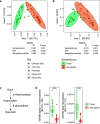Biotransformation of Rutin in In Vitro Porcine Ileal and Colonic Fermentation Models
- PMID: 37578464
- PMCID: PMC10452667
- DOI: 10.1021/acs.jafc.3c00980
Biotransformation of Rutin in In Vitro Porcine Ileal and Colonic Fermentation Models
Abstract
Quercetin, a polyphenol antioxidant, is widely distributed in food in the form of glycoside rutin, which is not readily absorbed in the gastrointestinal tract. The microbiota of the colon is known to biotransform rutin, generating quercetin aglycones that can be absorbed. We investigated the role of the ileal and colonic microbiota in rutin biotransformation using established in vitro fermentation models. Overall, a higher rate of rutin biotransformation was observed during colonic fermentation compared with ileal fermentation. The colonic microbiome showed higher potential for rutin conversion to quercetin through an increased abundance of α-rhamnosidase- and β-glucosidase-encoding genes compared to the ileal microbiome. Nonetheless, rutin metabolism occurred rapidly during ileal fermentation (∼20% rutin disappearance after 1 h). The appearance of quercetin varied depending on the ileal inoculum and correlated with an increased abundance of Firmicutes, suggesting that quercetin absorption could be improved via modulation of the ileal microbiota.
Keywords: colon fermentation; fecal microbiome; ileal fermentation; ileal microbiome; polyphenol biotransformation.
Conflict of interest statement
The authors declare no competing financial interest.
Figures




References
MeSH terms
Substances
LinkOut - more resources
Full Text Sources

